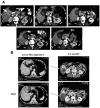Novel approaches to treatment of hepatocellular carcinoma and hepatic metastases using thermal ablation and thermosensitive liposomes
- PMID: 23622079
- PMCID: PMC3738918
- DOI: 10.1016/j.soc.2013.02.009
Novel approaches to treatment of hepatocellular carcinoma and hepatic metastases using thermal ablation and thermosensitive liposomes
Abstract
Because of the limitations of surgical resection, thermal ablation is commonly used for the treatment of hepatocellular carcinoma and liver metastases. Current methods of ablation can result in marginal recurrences of larger lesions and in tumors located near large vessels. This review presents a novel approach for extending treatment out to the margins where temperatures do not provide complete treatment with ablation alone, by combining thermal ablation with drug-loaded thermosensitive liposomes. A history of the development of thermosensitive liposomes is presented. Clinical trials have shown that the combination of radiofrequency ablation and doxorubicin-loaded thermosensitive liposomes is a promising treatment.
Copyright © 2013 Elsevier Inc. All rights reserved.
Conflict of interest statement
Conflict of Interest Statement: Dr Dewhirst holds stock in the Celsion Corporation
Figures






References
-
- Poon R, Borys N. Lyso-thermosensitive liposomal doxorubicin: a novel approach to enhance efficacy of thermal ablation of liver cancer. Expert Opin Pharmacother. 2009;10(2):333–43. - PubMed
-
- Lencioni R, Crocetti L, Cioni D, et al. Percutaneous radiofrequency ablation of hepatic colorectal metastases–technique, indications, results, and new promises. Invest Radiol. 2004;39(11):689–97. - PubMed
-
- Solbiati L, Livraghi T, Goldberg SN, et al. Percutaneous radio-frequency ablation of hepatic metastases from colorectal cancer: long-term results in 117 patients. Radiology. 2001;221(1):159–66. - PubMed
-
- Stauffer PR, Diederich CJ, Seegenschmiedt MH. Interstitial heating technologies. In: Seegenschmiedt MH, Fessenden P, Vernon CC, editors. Thermoradiotherapy and thermochemotherapy: volume 1, biology, physiology and physics. Berlin, New York: Springer-Verlag; 1995. pp. 279–320.
-
- Stauffer PR, Goldberg SN. Introduction: thermal ablation therapy. Int J Hyperthermia. 2004;20(7):671–7. - PubMed
Publication types
MeSH terms
Substances
Grants and funding
LinkOut - more resources
Full Text Sources
Other Literature Sources
Medical

